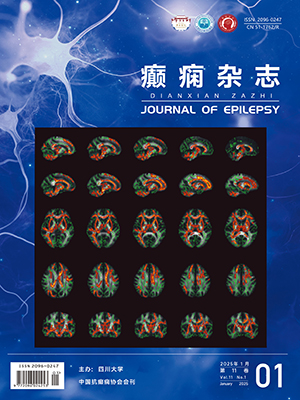| 1. |
Thorburn DR. Mitochondrial disorders: prevalence, mythsand advances. J Inherit Metab Dis, 2004, 27(3): 349-362.
|
| 2. |
Lee HF, Chi CS, Tsai CR, et al. Epileptic seizures ininfants and children with mitochondrial diseases. Pediatr Neurol, 2011, 45(11): 169-174.
|
| 3. |
NI Wolf, JAM Smeitink. Mitochondrial disorders: a proposal for consensus diagnostic criteria in infants and children. Neurology, 2002, 59(20): 1402-1405.
|
| 4. |
J Schmiedel, S Jackson, J Schäfer, et al. Mitochondrial cytopathies. J Neurol, 2003, 250 (31): 267-277.
|
| 5. |
Khurana DS, Salganicoff L, Melvin JJ, et al. Epilepsy andrespiratory chain defects in children with mitochondrial encephalopathies.Neuro Pediatrics, 2008, 39(1): 8-13.
|
| 6. |
Parikh S, Cohen BH, Gupta A, et al. Metabolic testing in the pediatric epilepsy unit.PediatrNeurol, 2008, 38(2): 191-195.
|
| 7. |
Oliveira AR, Valente R, Ramos J, et al. Persistenthyperlactacidaemia: about a clinical case. BMJ Case Rep, 2013, 22(5): 009485.
|
| 8. |
Jackson MJ, Schaefer JA, Johnson MA, et al.Presention and clinicalinvestigation of mitochondrial respiratory chain disease: a study of 51patients. Brain, 1995, 118( 2): 339-357.
|
| 9. |
高素琴, 焉传祝, 刘淑萍, 等.单纯型线粒体肌病的临床和病理特点.临床神经病学杂志, 2005, 18( 1): 7-9.
|
| 10. |
Gieraerts C, Demaerel P, van Damme P, et al. Mitochondrialencephalomyopathy, lactic acidosis, and stroke-like episodes (MELAS) syndrome mimicking herpes simplex encephalitis on imaging studies. J Comput Assist Tomogr, 2013, 37(10): 279-281.
|
| 11. |
Iizuka T, Sakai F, Ide T, et al. Regional cerebral bloodflow and cerebrovascular reactivity during chronicstage of stroke-like episodes in MELAS-implication of neurovascular cellular mechanism. Brain Dev, 2008, 30(7): 100-105.
|
| 12. |
Gilchrist JM, Sikirica M, Stipa E, et al. Adult-onset MELAS Evidence for involvement of neurons as well as cerebral vasculature in stroke-like episodes. Stroke, 1996, 27(5): 420-423.
|
| 13. |
Clark JM, Marks MP, Adalsteinsson E, et al. MELAS:clinical and pathologic correlations with MRI, xenon/CT, and MR spectroscopy. Neurology, 1996, 46(9): 223-227.
|
| 14. |
Hoon-Chul Kang, Young-Mock Lee, Heung Dong Kim. Mitochondrial disease and epilepsy. Brain & Development, 2013, 35 (23): 757-761.
|
| 15. |
Lin CM, Thajeb P. Valproic acid aggravates epilepsy due to MELAS in a patient with an A3243G mutation of mitochondrial DNA. Metab Brain Dis, 2007, 22 (16): 105-109.
|
| 16. |
Lam CW, Lau CH, Williams JC, et al. Mitochondrial myopathy, encephalopathy, lactic acidosis and stroke-like episodes (MELAS) triggered by valproate therapy. Eur J Pediatr, 1997, 15(6): 562-564.
|
| 17. |
Galimberti CA, Diegoli M, Sartori I, et al. Brain pseudoatrophy and mental regression on valproate and a mitochondrial DNA mutation. Neurology, 2006, 67(12): 1715-1717.
|
| 18. |
Chabrol B, Mancini J, Chretien D, et al. Valproate-induced hepatic failure in a case of cytochrome c oxidase deficiency. Eur J Pediatr, 1994, 153(22): 133-135.
|
| 19. |
Isohanni P, Hakonen AH, Euro L, et al. POLG1 manifestationsin childhood. Neurology, 2011, 76(10): 811-815.
|
| 20. |
Uusimaa J, Hinttala R, Rantala H, et al. Homozygous W748S mutation in the POLG1 gene in patients with juvenile-onset Alpers syndrome and status epilepticus. Epilepsia, 2008, 49(23): 1038-1045.
|
| 21. |
Wolf NI, Rahman S, Schmitt B, et al. Status epilepticus in children with Alpers' disease caused by POLG1 mutations: EEG and MRI features. Epilepsia, 2009, 50(13): 1596-1607.
|
| 22. |
Lheureux PE, Hantson P. Carnitine in the treatment of valproic acid-induced toxicity. Clin Toxicol (Phila), 2009, 47(11):101-111.
|
| 23. |
李文娜, 韩涛, 王雪, 等.线粒体脑肌病癫痫的药物治疗进展.中华神经科杂志, 2012, 45(2): 144-146.
|
| 24. |
田冉, 陈金亮.线粒体肌病10例临床分析.中风与神经疾病杂志, 2014, 13(8): 103-107.
|
| 25. |
Khurana DS, Valencia I, Goldenthal MJ, et al. Mitochondrial dysfunction in epilepsy. Semin Pediatr Neurol, 2013, 20(3):176-187.
|




